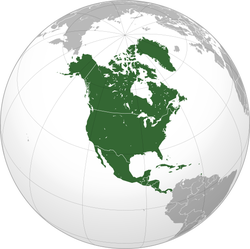North America
|
North America (Spanish: América del Norte or Norteamérica; French: Amérique du Nord) is the northern continent of the Americas,situated in the Earth's northern hemisphere and in the western hemisphere. It is bordered on the north by the Arctic Ocean, on the east by the North Atlantic Ocean, on the southeast by the Caribbean Sea, and on the west by the North Pacific Ocean; South America lies to the southeast of the continent.
North America covers an area of about 24,709,000 square kilometers (9,540,000 square miles), about 4.8% of the planet's surface or about 16.5% of its land area. As of July 2008, its population was estimated at nearly 529 million people. It is the third-largest continent in area, following Asia and Africa, and the fourth in population after Asia, Africa, and Europe.
North America covers an area of about 24,709,000 square kilometers (9,540,000 square miles), about 4.8% of the planet's surface or about 16.5% of its land area. As of July 2008, its population was estimated at nearly 529 million people. It is the third-largest continent in area, following Asia and Africa, and the fourth in population after Asia, Africa, and Europe.
Etymology
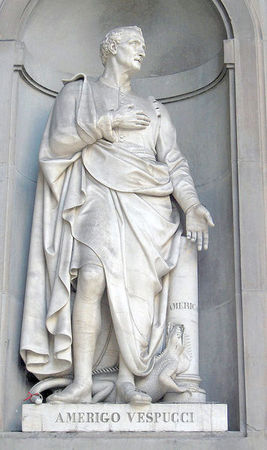
Amerigo Vespucci (March 9, 1454 – February 22, 1512)
The Americas are generally accepted as having been named after the Italian explorer Amerigo Vespucci by the German cartographers Martin Waldseemüller and Matthias Ringmann. Vespucci, who explored South America between 1497 and 1502, was the first European to suggest that the Americas were not the East Indies, but a different landmass previously unknown by Europeans.
(Note:Christopher Columbus was a trader and explorer. He was born in Genoa, Italy in the year 1451. He died on May 20, 1506 in Valladolid. Columbus is often considered the first European person to have discovered the Americas (North + South) when he landed in the Bahamas in 1492. Many people doubt this for several reasons. One of these is that though the Caribbean is often considered part of North America, it is not on the American mainland. Another is that some believe that America was discovered by the Viking Leif Ericson around 1000 AD. Still others doubt the idea of "discovery" of America at all, as Native Americans had been living there for thousands of years before Columbus.
While he did not actually discover the Americas, he discovered the Bahamas, however close to the Americas. He was once called the first European to find out because people already lived at the Americas, though it is known now that the Vikings did this earlier,Columbus wrote that he went to sea at the age of 14.)
In 1507, Waldseemüller produced a world map, in which he placed the word "America" on the continent of South America, in the middle of what is today Brazil.
For Waldseemüller, no one should object to the naming of the land after its discoverer. He used the Latinized version of Vespucci's name (Americus Vespucius), but in its feminine form "America", following the examples of "Europa" and "Asia".
Later, when other mapmakers added North America, they extended the original name to it as well: in 1538, Gerard Mercator used the name America to all of the Western Hemisphere on his world map.
Some argue that the convention is to use the surname for naming discoveries except in the case of royalty and so a derivation from "Amerigo Vespucci" could be problematic.Ricardo Palma (1949) proposed a derivation from the "Amerrique" mountains of Central America—Vespucci was the first to discover South America and the Amerrique mountains of Central America, which connected his discoveries to those of Christopher Columbus.
Alfred E. Hudd proposed a theory in 1908 that the continents are named after a Welsh merchant named Richard Amerike from Bristol, who is believed to have financed John Cabot's voyage of discovery from England to Newfoundland in 1497. A minutely explored belief that has been advanced is that America was named for a Spanish sailor bearing the ancient Visigothic name of 'Amairick'. Another is that the name is rooted in a Native American language.
(Note:Christopher Columbus was a trader and explorer. He was born in Genoa, Italy in the year 1451. He died on May 20, 1506 in Valladolid. Columbus is often considered the first European person to have discovered the Americas (North + South) when he landed in the Bahamas in 1492. Many people doubt this for several reasons. One of these is that though the Caribbean is often considered part of North America, it is not on the American mainland. Another is that some believe that America was discovered by the Viking Leif Ericson around 1000 AD. Still others doubt the idea of "discovery" of America at all, as Native Americans had been living there for thousands of years before Columbus.
While he did not actually discover the Americas, he discovered the Bahamas, however close to the Americas. He was once called the first European to find out because people already lived at the Americas, though it is known now that the Vikings did this earlier,Columbus wrote that he went to sea at the age of 14.)
In 1507, Waldseemüller produced a world map, in which he placed the word "America" on the continent of South America, in the middle of what is today Brazil.
For Waldseemüller, no one should object to the naming of the land after its discoverer. He used the Latinized version of Vespucci's name (Americus Vespucius), but in its feminine form "America", following the examples of "Europa" and "Asia".
Later, when other mapmakers added North America, they extended the original name to it as well: in 1538, Gerard Mercator used the name America to all of the Western Hemisphere on his world map.
Some argue that the convention is to use the surname for naming discoveries except in the case of royalty and so a derivation from "Amerigo Vespucci" could be problematic.Ricardo Palma (1949) proposed a derivation from the "Amerrique" mountains of Central America—Vespucci was the first to discover South America and the Amerrique mountains of Central America, which connected his discoveries to those of Christopher Columbus.
Alfred E. Hudd proposed a theory in 1908 that the continents are named after a Welsh merchant named Richard Amerike from Bristol, who is believed to have financed John Cabot's voyage of discovery from England to Newfoundland in 1497. A minutely explored belief that has been advanced is that America was named for a Spanish sailor bearing the ancient Visigothic name of 'Amairick'. Another is that the name is rooted in a Native American language.
Geography of North America
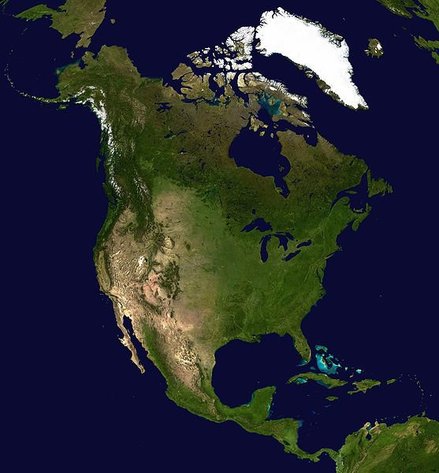
North America is the third largest continent, or a portion of the second largest if North and South America are combined into the Americas and Africa, Europe and Asia are considered to be part of one supercontinent called Afro-Eurasia.
It is bounded by the Pacific Ocean on the west; the Atlantic Ocean on the east; the Caribbean Sea, Atlantic and Pacific oceans, and South America on the south; and the Arctic Ocean on the north. The northern half of North America is sparsely populated and covered mostly by Canada, except for the northwestern portion which is occupied by Alaska, the largest state of the U.S. The central and southern portions of the continent are represented by the United States, Mexico, and numerous smaller states primarily in Central America and in the Caribbean.
North America consists of all the mainland and related offshore islands lying north of the Colombia-Panama border according to most sources or the Panama Canal according to a few.
The islands include Greenland, the world's largest island, and archipelagos and islands in the Caribbean.
The terminology of the Americas is complex, but "Anglo-America" can describe Canada and the U.S., while "Latin America" comprises Mexico and the countries of Central America and the Caribbean, as well as the entire continent of South America.
Natural features of North America include the northern portion of the American Cordillera, represented by the geologically new Rocky Mountains in the west; and the considerably older Appalachian Mountains to the east. The north hosts an abundance of glacial lakes formed during the last glacial period, including the Great Lakes. North America's major continental divide is the Great Divide, which runs north and south down through Rocky Mountains. The major watersheds all drain to the east: The Mississippi/Missouri and Rio Grande into the Gulf of Mexico, and St. Lawrence into the Atlantic.
Climate is determined to a large extent by the latitude, ranging from Arctic cold in the north to tropical heat in the south. The western half of North America tends to have milder and wetter climate than other areas with equivalent latitude, although there are steppes (known as "Parairies") in the central and western portions, and deserts in the Southwestern United States of Arizona, Colorado, California, Nevada, New Mexico, Utah, Oklahoma, and Texas; along with the Mexican states of Baja California, Baja California Sur, Sonora, Chihuahua, Coahuila, Nuevo Leon and Tamaulipas.
It is bounded by the Pacific Ocean on the west; the Atlantic Ocean on the east; the Caribbean Sea, Atlantic and Pacific oceans, and South America on the south; and the Arctic Ocean on the north. The northern half of North America is sparsely populated and covered mostly by Canada, except for the northwestern portion which is occupied by Alaska, the largest state of the U.S. The central and southern portions of the continent are represented by the United States, Mexico, and numerous smaller states primarily in Central America and in the Caribbean.
North America consists of all the mainland and related offshore islands lying north of the Colombia-Panama border according to most sources or the Panama Canal according to a few.
The islands include Greenland, the world's largest island, and archipelagos and islands in the Caribbean.
The terminology of the Americas is complex, but "Anglo-America" can describe Canada and the U.S., while "Latin America" comprises Mexico and the countries of Central America and the Caribbean, as well as the entire continent of South America.
Natural features of North America include the northern portion of the American Cordillera, represented by the geologically new Rocky Mountains in the west; and the considerably older Appalachian Mountains to the east. The north hosts an abundance of glacial lakes formed during the last glacial period, including the Great Lakes. North America's major continental divide is the Great Divide, which runs north and south down through Rocky Mountains. The major watersheds all drain to the east: The Mississippi/Missouri and Rio Grande into the Gulf of Mexico, and St. Lawrence into the Atlantic.
Climate is determined to a large extent by the latitude, ranging from Arctic cold in the north to tropical heat in the south. The western half of North America tends to have milder and wetter climate than other areas with equivalent latitude, although there are steppes (known as "Parairies") in the central and western portions, and deserts in the Southwestern United States of Arizona, Colorado, California, Nevada, New Mexico, Utah, Oklahoma, and Texas; along with the Mexican states of Baja California, Baja California Sur, Sonora, Chihuahua, Coahuila, Nuevo Leon and Tamaulipas.
Climate of North America
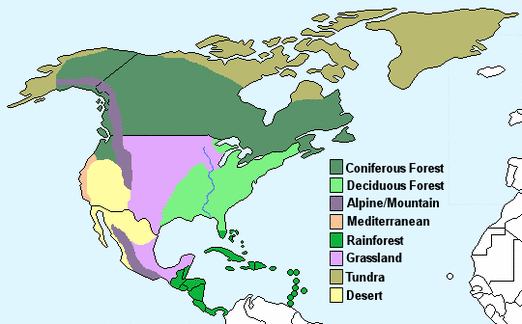
The climate of North America can be broadly divided into eight different climate types:
- Deciduous forest - Four distinct seasons with warm summers and cold, wet winters. The trees shed their leaves in autumn.
- Coniferous forest - Also known as Taiga, cold and dry with snowy winters and warmer summers.
- Mediterranean - Warm to high temperatures with rainfall in the autumn and winter months.
- Grassland - Hot summers and cold winters with above average rainfall.
- Tundra - This area is characterised by a layer of permafrost (soil that has remained below freezing for at least two years. Winters are very cold, summers are warm and there is little rainfall.
- Alpine/mountain - Cold, windy and snowy. It is winter from October to May with temperatures below freezing, while summer is from June to September where the temperature can reach 15°C.
- Rainforest - High temperatures and high rainfall throughout the year.
History Of North America
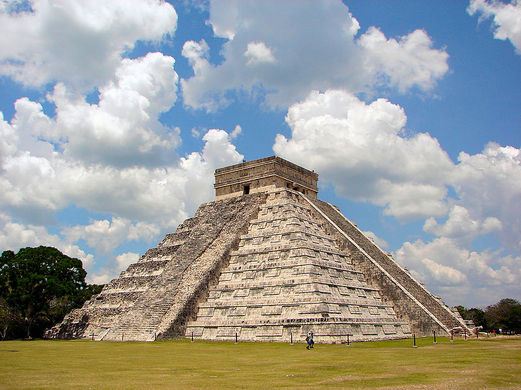
Chichen Itza built by the Maya civilization,Yucatán,Mexico.
The pre-Columbian era means the history and prehistory of the Americas before there were important European influences on the American continent.
The word pre-Columbian refers to the era before Christopher Columbus, but sometimes it can include the history of American indigenous cultures as they continued to develop after the Christopher Columbus' first landing in 1492, until they were conquered or influenced by Europeans, even if this happened decades or even centuries after the arrival of Columbus.
Pre-Columbian can also mean cultures of any one of the great native civilizations of the Americas, such as those of Mesoamerica (the Aztec and Maya) and of the Andes (Inca, Moche and Chibcha).
There was limited contact between North American peoples and the outside world before 1492. Several theoretical contacts have been proposed, but the earliest physical evidence comes to us from the Norse or Vikings. Norse captain Leif Ericson is believed to have reached the Island of Newfoundland circa 1000 AD. They named their new discovery Vinland. The only Norse site yet discovered in North America is at L'Anse aux Meadows, Newfoundland and Labrador. The Norse colonies were later abandoned.
The Viking voyages did not become common knowledge in the Old World, and Europeans remained ignorant of the existence of the Americas, until 1492. As part of a general age of discovery Italian sailor Christopher Columbus proposed a voyage west from Europe to find a shorter route to Asia. He eventually received the backing of Isabella I and Ferdinand II, Queen and King of newly united Spain. In 1492 Columbus reached land in the Bahamas.
Almost 500 years after the Norse, John Cabot explored the east coast of what would become Canada in 1497. Giovanni da Verrazzano explored the East Coast of America from Florida to presumably Newfoundland in 1524. Jacques Cartier made a series of voyages on behalf of the French crown in 1534 and penetrated the St. Lawrence River.
Initially, European activity consisted mostly of trade and exploration. Eventually Europeans began to establish settlements. The three principal colonial powers were Spain, England, and France, although eventually even small powers like the Netherlands and Sweden received minor holdings on the continent.
Settlement by the Spanish started the European colonization of the Americas.They gained control of most of the largest islands in the Caribbean and conquered the Aztecs, gaining control of present-day Mexico and Central America. This was the beginning of the Spanish Empire in the New World. The first successful Spanish settlement in continental North America was Veracruz in 1519, followed by many other settlements in colonial New Spain and Spanish Florida.
The first successful English settlements were at Jamestown (1607) (along with its satellite, Bermuda in 1609) and Plymouth (1620), in what are today Virginia and Massachusetts respectively. The first French settlements were Port Royal (1604) and Quebec City (1608) in what is now Nova Scotia and Quebec. The Fur Trade soon became the primary business on the continent and as a result transformed the Native Americans lifestyle.
Further to the south, plantation slavery became the main industry of the West Indies, and this gave rise to the beginning of the Atlantic slave trade.
The coming of the American Revolution had a great impact across the continent. Most importantly it directly led to the creation of the United States of America. However, the associated American Revolutionary War was an important war that touched all corners of the region. The flight of the United Empire Loyalists led to the creation of English Canada as a separate community. Meanwhile, Spain's hold on Mexico was weakening. Independence was declared in 1810 by Miguel Hidalgo, starting the Mexican War of Independence. In 1813, José María Morelos and the Congress of Anáhuac signed the Solemn Act of the Declaration of Independence of Northern America, the first legal document where the separation of the New Spain with respect to Spain is proclaimed. Spain finally recognized Mexico's independence in 1821.
From the time of independence of the United States, that country expanded rapidly to the west, acquiring the massive Louisiana territory in 1803. An attempt at northern expansion was blocked by Britain during the War of 1812. At the same time, British settlement in Canada increased. US expansion was complicated by the division between "free" and "slave" states, which led to the Missouri Compromise 1820. Likewise, Canada faced a division between French and English communities that led to the outbreak of civil strife in 1837. Mexico faced constant political tensions between liberals and conservatives, as well as the rebellion of the English-speaking region of Tejas, which declared itself the Republic of Texas 1836. In 1845 Texas joined the United States, which would later lead to the Mexican–American War. As a result of conflict with Mexico, the United States made further territorial gains in California and the Southwest.
As a part of the British Empire Canada immediately was at war in 1914. Canada bore the brunt of several major battles during the early stages of the war including the use of poison gas attacks at Ypres. Losses became grave, and the government eventually brought in conscription, despite the fact this was against the wishes of the majority of French Canadians. In the ensuing Conscription Crisis of 1917, riots broke out on the streets of Montreal. In neighboring Newfoundland, the new dominion suffered a devastating loss on July 1, 1916, the First day on the Somme.
The United States stayed apart from the conflict until 1917, joining the Entente powers. The United States was then able to play a crucial role at the Paris Peace Conference of 1919 that shaped interwar Europe.
Once again Canada found herself at war before her neighbours, however even Canadian contributions were slight before the Japanese attack on Pearl Harbor.
The entry of the United States into the war helped to tip the balance in favour of the allies.
Two Mexican tankers, transporting oil to the United States, were attacked and sunk by the Germans in the Gulf of Mexico waters, in 1942. The incident happened in spite of Mexico's neutrality at that time. This led Mexico to declare war to the Axis nations and entered the conflict.The destruction of Europe wrought by the war vaulted all North American countries to more important roles in world affairs. The United States especially emerged as a "superpower".
The word pre-Columbian refers to the era before Christopher Columbus, but sometimes it can include the history of American indigenous cultures as they continued to develop after the Christopher Columbus' first landing in 1492, until they were conquered or influenced by Europeans, even if this happened decades or even centuries after the arrival of Columbus.
Pre-Columbian can also mean cultures of any one of the great native civilizations of the Americas, such as those of Mesoamerica (the Aztec and Maya) and of the Andes (Inca, Moche and Chibcha).
There was limited contact between North American peoples and the outside world before 1492. Several theoretical contacts have been proposed, but the earliest physical evidence comes to us from the Norse or Vikings. Norse captain Leif Ericson is believed to have reached the Island of Newfoundland circa 1000 AD. They named their new discovery Vinland. The only Norse site yet discovered in North America is at L'Anse aux Meadows, Newfoundland and Labrador. The Norse colonies were later abandoned.
The Viking voyages did not become common knowledge in the Old World, and Europeans remained ignorant of the existence of the Americas, until 1492. As part of a general age of discovery Italian sailor Christopher Columbus proposed a voyage west from Europe to find a shorter route to Asia. He eventually received the backing of Isabella I and Ferdinand II, Queen and King of newly united Spain. In 1492 Columbus reached land in the Bahamas.
Almost 500 years after the Norse, John Cabot explored the east coast of what would become Canada in 1497. Giovanni da Verrazzano explored the East Coast of America from Florida to presumably Newfoundland in 1524. Jacques Cartier made a series of voyages on behalf of the French crown in 1534 and penetrated the St. Lawrence River.
Initially, European activity consisted mostly of trade and exploration. Eventually Europeans began to establish settlements. The three principal colonial powers were Spain, England, and France, although eventually even small powers like the Netherlands and Sweden received minor holdings on the continent.
Settlement by the Spanish started the European colonization of the Americas.They gained control of most of the largest islands in the Caribbean and conquered the Aztecs, gaining control of present-day Mexico and Central America. This was the beginning of the Spanish Empire in the New World. The first successful Spanish settlement in continental North America was Veracruz in 1519, followed by many other settlements in colonial New Spain and Spanish Florida.
The first successful English settlements were at Jamestown (1607) (along with its satellite, Bermuda in 1609) and Plymouth (1620), in what are today Virginia and Massachusetts respectively. The first French settlements were Port Royal (1604) and Quebec City (1608) in what is now Nova Scotia and Quebec. The Fur Trade soon became the primary business on the continent and as a result transformed the Native Americans lifestyle.
Further to the south, plantation slavery became the main industry of the West Indies, and this gave rise to the beginning of the Atlantic slave trade.
The coming of the American Revolution had a great impact across the continent. Most importantly it directly led to the creation of the United States of America. However, the associated American Revolutionary War was an important war that touched all corners of the region. The flight of the United Empire Loyalists led to the creation of English Canada as a separate community. Meanwhile, Spain's hold on Mexico was weakening. Independence was declared in 1810 by Miguel Hidalgo, starting the Mexican War of Independence. In 1813, José María Morelos and the Congress of Anáhuac signed the Solemn Act of the Declaration of Independence of Northern America, the first legal document where the separation of the New Spain with respect to Spain is proclaimed. Spain finally recognized Mexico's independence in 1821.
From the time of independence of the United States, that country expanded rapidly to the west, acquiring the massive Louisiana territory in 1803. An attempt at northern expansion was blocked by Britain during the War of 1812. At the same time, British settlement in Canada increased. US expansion was complicated by the division between "free" and "slave" states, which led to the Missouri Compromise 1820. Likewise, Canada faced a division between French and English communities that led to the outbreak of civil strife in 1837. Mexico faced constant political tensions between liberals and conservatives, as well as the rebellion of the English-speaking region of Tejas, which declared itself the Republic of Texas 1836. In 1845 Texas joined the United States, which would later lead to the Mexican–American War. As a result of conflict with Mexico, the United States made further territorial gains in California and the Southwest.
As a part of the British Empire Canada immediately was at war in 1914. Canada bore the brunt of several major battles during the early stages of the war including the use of poison gas attacks at Ypres. Losses became grave, and the government eventually brought in conscription, despite the fact this was against the wishes of the majority of French Canadians. In the ensuing Conscription Crisis of 1917, riots broke out on the streets of Montreal. In neighboring Newfoundland, the new dominion suffered a devastating loss on July 1, 1916, the First day on the Somme.
The United States stayed apart from the conflict until 1917, joining the Entente powers. The United States was then able to play a crucial role at the Paris Peace Conference of 1919 that shaped interwar Europe.
Once again Canada found herself at war before her neighbours, however even Canadian contributions were slight before the Japanese attack on Pearl Harbor.
The entry of the United States into the war helped to tip the balance in favour of the allies.
Two Mexican tankers, transporting oil to the United States, were attacked and sunk by the Germans in the Gulf of Mexico waters, in 1942. The incident happened in spite of Mexico's neutrality at that time. This led Mexico to declare war to the Axis nations and entered the conflict.The destruction of Europe wrought by the war vaulted all North American countries to more important roles in world affairs. The United States especially emerged as a "superpower".
Countries and territories
There are 38 countries and Islands in North America.
North America
Central America
|
Caribbean
|
Religion in North America
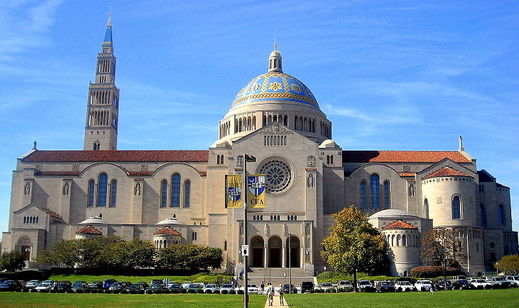
Basilica of the National Shrine of the Immaculate Conception,Washington, D.C.
Christianity is the major religion of North America.Muslims have been arriving in the New World from the sixteenth century to the present.
The majority of Americans (76%) identify themselves as Christians, mostly within Protestant and Catholic denominations, accounting for 51% and 25% of the population respectively.Non-Christian religions (including Buddhism, Hinduism, Islam, and Judaism), collectively make up about 3.9% to 5.5% of the adult population.Another 15% of the adult population identifies as having no religious belief or no religious affiliation
The 2001 Canadian census reported that 77% of Canadians claim adherence to Christianity,Islam 2%,Judaism 1.1%,Hinduism 1.0%,Buddhism 1.0%,Sikhism 0.9% followed by no religion at 16%.
The 2010 census by the Instituto Nacional de Estadística y Geografía (Mexico) gave Roman Catholicism as the main religion, with 82.7% of the population, while 9.7% (10,924,103) belong to other Christian denominations, including Evangelicals (5.2%); Pentecostals (1.6%); other Protestant or Reformed (0.7%); Jehovah's Witnesses (1.4%); Seventh-day Adventists (0.6%); and LDS Church Mormons (0.3%),4.7% declared having no religion; 2.7% were unspecified..
Islam is mainly practiced by members of the Arab, Turkish, and other expatriate communities, though there is a very small number of the indigenous population in Chiapas that practices Islam. Official data estimates in the 2008 census show that there are 25,000 Muslims in Mexico.
The presence of Jews in Mexico dates back to 1521, when Hernán Cortéz conquered the Aztecs, accompanied by several Conversos. According to the last national census by the INEGI, there are now more than 45,000 Mexican Jews. the near totality of which (around 95%) live in the Greater Mexico City area.
The majority of Americans (76%) identify themselves as Christians, mostly within Protestant and Catholic denominations, accounting for 51% and 25% of the population respectively.Non-Christian religions (including Buddhism, Hinduism, Islam, and Judaism), collectively make up about 3.9% to 5.5% of the adult population.Another 15% of the adult population identifies as having no religious belief or no religious affiliation
The 2001 Canadian census reported that 77% of Canadians claim adherence to Christianity,Islam 2%,Judaism 1.1%,Hinduism 1.0%,Buddhism 1.0%,Sikhism 0.9% followed by no religion at 16%.
The 2010 census by the Instituto Nacional de Estadística y Geografía (Mexico) gave Roman Catholicism as the main religion, with 82.7% of the population, while 9.7% (10,924,103) belong to other Christian denominations, including Evangelicals (5.2%); Pentecostals (1.6%); other Protestant or Reformed (0.7%); Jehovah's Witnesses (1.4%); Seventh-day Adventists (0.6%); and LDS Church Mormons (0.3%),4.7% declared having no religion; 2.7% were unspecified..
Islam is mainly practiced by members of the Arab, Turkish, and other expatriate communities, though there is a very small number of the indigenous population in Chiapas that practices Islam. Official data estimates in the 2008 census show that there are 25,000 Muslims in Mexico.
The presence of Jews in Mexico dates back to 1521, when Hernán Cortéz conquered the Aztecs, accompanied by several Conversos. According to the last national census by the INEGI, there are now more than 45,000 Mexican Jews. the near totality of which (around 95%) live in the Greater Mexico City area.
Economy of North America
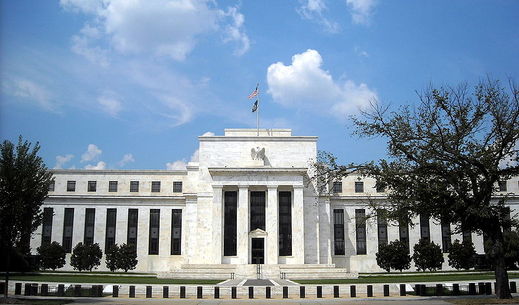
Headquarters of Federal Reserve System-central banking system of the United States
The economy of North America comprises more than 528 million (8% of the world population) people in 23 sovereign states and 15 dependent territories. It is marked by a sharp division between the predominantly English speaking countries of Canada and the United States, which are among the wealthiest and most developed nations in the world, and the countries of Central America and the Caribbean that are less developed. Mexico lies in between these two extremes as a newly industrialized country (NIC), and is a part of the North American Free Trade Agreement (NAFTA) and the only Latin American member of the Organisation for Economic Co-operation and Development (OECD). The United States is by far the largest economy in North America and the largest national economy in the world.

